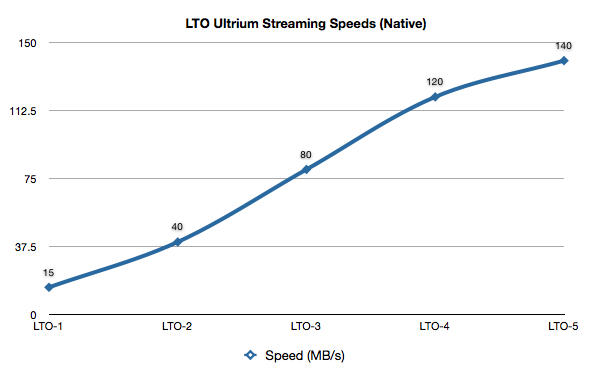The much long-anticipated wait for LTO-5 is now approaching fulfilment, with stories such as “Mass Production of Sony LTO-5 Media Has Started” further reinforcing that this next generation enterprise tape format is about to start rolling into datacentres.
One of the biggest advantages of LTO-5 is that while the capacity has effectively doubled from LTO-4, we’ve not seen a comparable doubling in streaming speed. LTO-4 had a native streaming speed of 120 MB/s, which has caused more than a few headaches to backup administrators trying to keep it running at full speed. (Indeed, it’s an example of why I earlier posted “Direct to Tape is Dead, Long Live Tape“).
LTO-5, while moving to a native capacity of 1.5TB increases the native streaming speed by only 20MB/s – giving us a native streaming speed of 140MB/s. This still isn’t going to always be easy to achieve, but bearing in mind that each previous generation LTO technology has typically doubled the streaming speed of the one before it, 140MB/s is going to be a lot easier to integrate into the datacentre than 240MB/s would have been!
Looking at the generational specifications, we get:
| Pros | Cons |
|---|---|
| Provides image level backup functionality for virtual machines, allowing for considerably faster backup options, unconstrained by traditional performance limitations, particularly of dense filesystems. | Only supported File Level Recovery (FLR) for Windows virtual machines. |
| A variety of backup connection methods, including HotAdd, NBD and SAN connect means that most environment scenarios are catered for. | Earlier versions of VADP backup did experience some issues where snapshots might not be successfully released. |
| A VADP proxy could support the backup of virtual machines from multiple vCenter servers. | Even for maximally configured VADP environments, a maximum of 8 virtual machine disk files could be backed up simultaneously. While this is mitigated by the speed of block level backups, it does result in higher numbers of VADP proxies being deployed in large environments. |
| When configured correctly, supports both file (Windows-only) and image level recovery from just the image level backup. | Not all virtual disk types are supported for backup, which can lead to a non-holistic approach. |
| Supports VM image level backup to tape (virtual or physical) as well as advanced file type devices and Data Domain systems. | Databases and other applications running within virtual machines (e.g., Oracle, Exchange, etc.) still require in-guest module backups, which in turn require the presence of in-guest filesystem agent software, even if it wasn't used. |
| In order to facilitate FLR back into the virtual machine, the NetWorker filesystem agent still needs to be installed on the client. |
Note – all compression sizes and speeds quoted at standard vendor estimate of 2:1 compression ratio. In reality, we all know that 2:1 compression ratios only occur on a small subset of data, and it’s usually better to estimate either a conservative compression ratio of 1.3:1, or if you want to be optimistic, a compression ratio of 1.4:1, unless you’re very certain that your data is highly compressible.
If you want to see these figures graphically, here we go:
I’m not aware of the hard numbers, but anecdotally I’ve heard time and time again that a lot of sites have been reluctant to go up to LTO-4 from LTO-3 because they’ve not been ready to upgrade their infrastructure to support the streaming speed of LTO-4. Some have argued this is clear indication that LTO-5 will struggle for adoption. I beg to differ – while LTO-4 was effectively ahead of its time by a considerable margin, LTO-5 will instead enter a more sophisticated datacentre with better approaches to tape usage within the backup environment. In the cases of datacentres still using LTO-3, it will also be entering environments that are well an truly ready to upgrade their infrastructure. This article about HP’s strategy for LTO-5 that I was referred to this morning shows they have a similar vein of thought to me on this front.
The end result will be that a lot of sites that have stayed on LTO-3 will see good reason to make the step directly from that format up to LTO-5. The streaming speeds will only increase by just a little over double, but the native capacity will jump on those sites from 400 GB to 1.5TB – that sort of capacity increase will justify the expenditure required to hit the new speed target of LTO-5.

